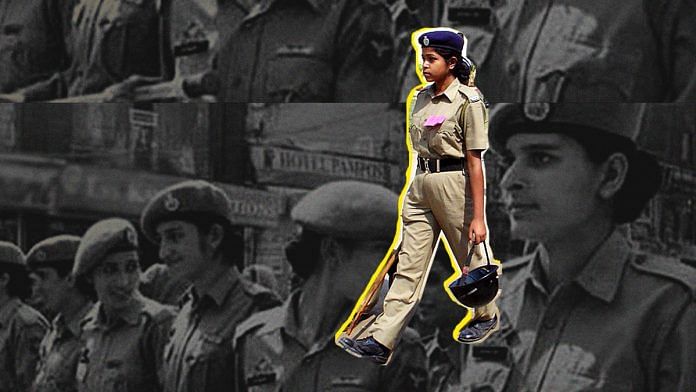Karnataka policewomen have been ordered to wear khaki shirts and pants and not saris, so that they can move quickly and work more efficiently. Policewomen have also been asked not to use makeup, dye or wear flowers in their hair.
ThePrint asks: Karnataka women cops to wear shirt & pants, not sari — More practical or forced Westernism?
Officers should look smart and be efficient, sari or salwar kameez can’t do that
 S. Parashivamurthy
S. Parashivamurthy
ADGP (administration), Karnataka Police
It is the officers who are on the heavier side who are objecting to wearing this kind of uniform. Our decision is based on the fact that if they wear the suggested uniform of pant and shirt, they will be able to work more efficiently. They will be able to run around with more ease. This decision has been taken after discussing with all women officers.
Our director general of police discussed it with all the women officers who were in the committee before a final decision was taken. The basic problem is that all the women officers who are used to wearing saris have been feeling awkward to wear pants. If they get used to it, they will begin to like it. There will be an initial hiccup. It is the constabulary who are usually seen in a sari, but they are the ones who move around more. They don’t have an administrative job, so a sari should not become a hindrance in their work. When a police officer is on the job, not only should she look smart, her presence should be commanding, and a salwar kameez or a sari cannot bring about that image. When it comes to aesthetics, different people will have different options, but when it comes to comfort, this new decision is being seen as the best option.
Initially there is bound to be an objection, but subsequently, they will adjust to this. This new uniform format will also automatically force officers to remain fit and smart. One should see it as a positive change.
Essential that women police not seen as different from others, in uniform too
 Jija Hari Singh
Jija Hari Singh
Former Karnataka DGP (Fire and Emergency Services, Home Guards and Civil Defence)
In 1980, there was an all-India conference at the National Police Academy, Hyderabad, to decide the uniform for women in the IPS. Until then, there was no distinction between men and women in any manner, in their recruitment, in their training or even in the exercise schedules. All the women IPS officers were called; Kiran Bedi, Kanchan Chaudhari, Jija Hari Singh, Manjari Jaruhar, Letika Saran and Aruna Bahuguna were also there. Everybody at that time had said that women should wear the same uniform as men because the sari is not suitable for the work they need to do.
Policing is an arduous task, it is not a desk job and is hard. One may even have to climb over walls and has to be ready. You should have the confidence and the facilitating attire to do that. And since there is no gender distinction during the qualifying exams of the Indian Police Service, there should be no difference in uniforms either. We did not want to have a distinction in appearance as a serving “woman” officer.
In the 1970s, gender discrimination was ever higher than it is today and the attitude of the older men in service was rigid. They had a prejudice against women in positions of power. Therefore, it was essential that we were seen as “not different” from others.
Coming to the constabulary, in Karnataka, in 1978, there was a committee constituted by State government under the Chairmanship of then police chief B. N. Garudachar to review the uniform policy. At the time, the youngsters who were being recruited wanted to wear shirts and pants, but the older people preferred to wear a sari. It was then that we thought we could allow them to wear a sari as the older women used to deal only with gentle duties like women prisoner escort, matters related to women and child welfare and not really called upon to do the job that today the head constables or constables are doing. Now that we are one generation ahead, it is time we shift to this smarter uniform as it is practical and also will keep our officers fit.
When required to wear this new uniform, women will have an incentive to keep slim and fit. Further, women across the world, even if they are bulky, wear such clothing and one should not feel ashamed of their physical structure.
It is important women officers feel comfortable in what they wear
 Aakansha Maheshwari
Aakansha Maheshwari
Fashion stylist
The shirt-pant combination is definitely better than a sari, but every woman’s physique is different and therefore it’s important that they feel comfortable in what they wear.
When I had suggested the uniform to the Telangana Police, I gave them two options: one was a salwar kameez combination, other was shirt and pants. For the latter, the waistcoat was longer than the shirt, thereby addressing any discomfort women may have with such attire.
At the same time, women may feel uncomfortable wearing a salwar kameez without a dupatta. That’s why I suggested a shorter waistcoat to go along with it. It takes care of comfort as well as doesn’t impede their movement.
The Karnataka Police’s decision is more about practicality because women officers are on the job 24×7, and their movement should not be restricted by clothes they wear. They have to ensure law and order, and are out in the sun for long hours, so the least one can do is provide them with smart and comfortable clothes.
Salwar kameez as an option would have been okay too
 Shankar Bidari
Shankar Bidari
Former Bengaluru Police Commissioner
This transition is fine, and should not be an issue. Earlier there was an option of saris, but implementing a shirt-pant dress code is a good decision.
If you ask me if there is a tilt towards Westernism, I would say yes. Salwar kameez as an option would have been okay too. But, on the whole, it is a good call to ask all women officers to dress in a similar fashion.
Sari is our tradition, but if you look at day-to-day practicality, pant-shirts will help more. It will make it easier for women officers to work efficiently. The argument here is that sari is cumbersome, and it hinders movement – women constables wearing saris can find it difficult to run while chasing an accused.
In between all this, I would like to ask why the need to make this change now?
By Rohini Swamy.






